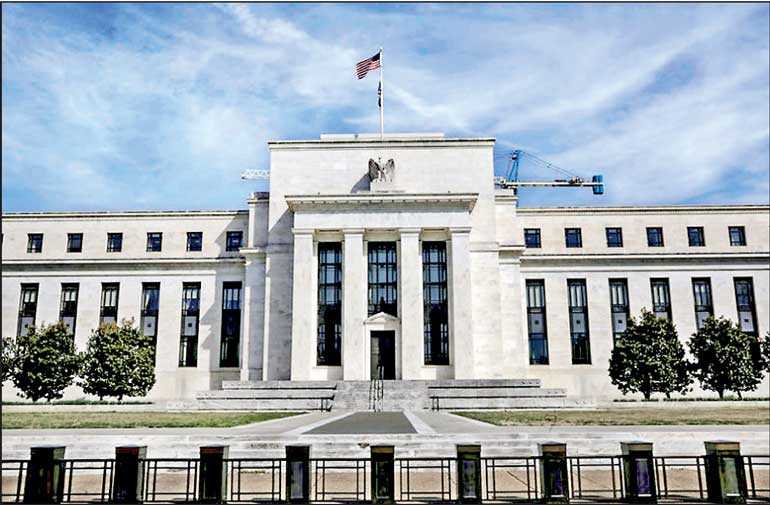Saturday Mar 15, 2025
Saturday Mar 15, 2025
Wednesday, 1 May 2019 00:00 - - {{hitsCtrl.values.hits}}

WASHINGTON (Reuters): The Federal Reserve is expected to hold interest rates steady at its policy meeting this week as policymakers balance recent stronger-than-expected US economic growth against sluggish inflation.
Officials have given no signal in recent weeks of any change to the US central bank’s benchmark overnight lending rate, currently set in a range of 2.25% to 2.50%. Markets have bet heavily the Fed’s “patient” approach means just that – with rates on hold until a run of good or bad news about the economy provides a compelling reason to move.
Data compiled by CME Group put the odds the Fed leaves rates unchanged this week at 97%.
“We do not expect a big change in tone,” compared to the Fed’s mid-March policy statement, with policymakers likely to be “more upbeat on growth, though with a more cautious reading of recent inflation developments,” JP Morgan economist Michael Feroli wrote in a preview of this week’s meeting.
The policy-setting Federal Open Market Committee is due to release its latest statement at 2 p.m. EDT (1800 GMT) on Wednesday after the end of a two-day meeting. Fed Chairman Jerome Powell will hold a press conference shortly after.
In the weeks since the Fed’s March meeting, most of the incoming US data has surprised in a positive way, diminishing the likelihood officials might be compelled to cut rates as President Donald Trump has demanded.
The gap in interest rates between different types of bonds, which narrowed in late March in what could be construed as a growing concern about recession, has since become larger as recession concerns eased.
Gross domestic product grew at an annualised rate of 3.2% for the first three months of the year, comparable to last year’s pace. The 3% growth achieved in 2018 surprised many at the central bank, and in their March statement officials said they thought the economy had slowed in the first weeks of this year.
After adding a meagre 33,000 jobs in February, US employers added nearly 200,000 in March. The S&P 500 index also hit a new record high and US retail sales rebounded in March after a lull.
“The GDP figures – along with the strong rebound in retail sales and durable goods orders in March – are a testament to the economy’s resilience,” analysts at Oxford Economics wrote last week.
It is the type of data, in fact, that until a few weeks ago might have set the stage for an interest rate increase.
But a round of volatility in stock and bond markets late last year, coupled with weak inflation and signs of a global economic slowdown, prompted the Fed to change its plans for further hikes and shift to a strategy of staying on hold until something changes. The Fed raised rates four times last year, and as late as December envisioned more increases this year.
Inflation in particular continues to fall short of the Fed’s 2% goal, and was just 1.5% on an annualised basis in the most recent report. Some officials, most notably Fed Vice Chairman Richard Clarida, have said they also feel inflation expectations are nearing uncomfortably low levels.
Fed officials watch different measures of inflation expectations almost as closely as the actual inflation numbers, and view them as central to the future rate of price increases.
That’s a strong reason, analysts say, for the Fed to hold off on rate hikes until it’s clear inflation is moving higher. Faced with the “dichotomy” of continuing economic growth and below-target inflation, “the Fed should keep policy on hold at its May FOMC meeting as it navigates the tug-of-war,” between the two, analysts at Deutsche Bank wrote.
Discover Kapruka, the leading online shopping platform in Sri Lanka, where you can conveniently send Gifts and Flowers to your loved ones for any event including Valentine ’s Day. Explore a wide range of popular Shopping Categories on Kapruka, including Toys, Groceries, Electronics, Birthday Cakes, Fruits, Chocolates, Flower Bouquets, Clothing, Watches, Lingerie, Gift Sets and Jewellery. Also if you’re interested in selling with Kapruka, Partner Central by Kapruka is the best solution to start with. Moreover, through Kapruka Global Shop, you can also enjoy the convenience of purchasing products from renowned platforms like Amazon and eBay and have them delivered to Sri Lanka.
Discover Kapruka, the leading online shopping platform in Sri Lanka, where you can conveniently send Gifts and Flowers to your loved ones for any event including Valentine ’s Day. Explore a wide range of popular Shopping Categories on Kapruka, including Toys, Groceries, Electronics, Birthday Cakes, Fruits, Chocolates, Flower Bouquets, Clothing, Watches, Lingerie, Gift Sets and Jewellery. Also if you’re interested in selling with Kapruka, Partner Central by Kapruka is the best solution to start with. Moreover, through Kapruka Global Shop, you can also enjoy the convenience of purchasing products from renowned platforms like Amazon and eBay and have them delivered to Sri Lanka.